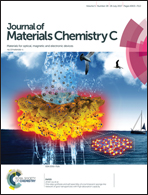Design principles of carbazole/dibenzothiophene derivatives as host material in modern efficient organic light-emitting diodes†
Abstract
Modern high-efficiency organic light-emitting diodes (OLEDs) based on phosphorescence and thermally activated delayed fluorescence (TADF) rely on host materials that are optimized with respect to many properties simultaneously, including thermal stability, photophysical properties, energy levels, and charge carrier transport. Responding to this challenge, we synthesized and investigated carbazole/dibenzothiophene derivatives as potential hosts, in which carbazole acts as electron donating and dibenzothiophene as electron withdrawing unit. Within this series, the carbazole/dibenzothiophene fraction and the linking phenyl spacer length were systematically varied. Through comprehensive assessment of all material parameters mentioned above and the performance of these host in phosphorescent and TADF OLEDs, we could reliably identify the most suitable molecule for applications and provide guidelines for further material development. With 9-(3′-(dibenzo[b,d]thiophen-4-yl)-[1,1′-biphenyl]-3-yl)-9H-carbazole, bearing one carbazole and one dibenzothiophene unit linked with biphenyl in meta position, we achieved high external quantum efficiency for blue (17.9%) and green (19.4%) modern OLEDs.



 Please wait while we load your content...
Please wait while we load your content...